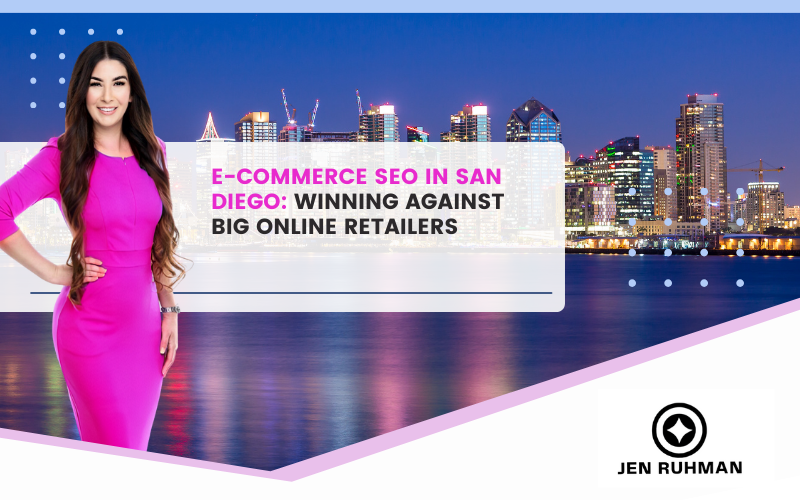E-Commerce SEO in San Diego: How I Help Local Stores Beat Big Retailers
AI-Overview — Direct Answers (For SGE & AI Search)
Can a San Diego e-commerce store outrank big retailers? Yes—by targeting hyper-local, problem-led, and long-tail keywords, building category hubs, optimizing Core Web Vitals, and leveraging local authority (reviews, press, and partnerships).
What delivers the fastest wins? Fix category pages, add unique product content, compress images, speed up pages, and ship local pickup/delivery pages that match “near me” intent.
What matters most? Entity-based local relevance (San Diego signals), clean internal linking, and review-backed trust.
Call/text me: (619) 719-1315. If you want a partner who lives and breathes e-commerce SEO here, I’m your person.
Why Listen to Me? (E-E-A-T & Local Proof)
I’m Jen Ruhman, owner of a San Diego SEO consultancy. I’ve helped local stores—from niche fashion and specialty sports to health & beauty—outrank national chains by leaning into what the giants can’t replicate: local intent, service, and speed. My home base is San Diego, so I build content and structure that Google can verify locally. If you’re looking for an SEO company San Diego or an SEO expert in San Diego who understands e-commerce and neighborhood search patterns, you’re in the right place.
A quick anecdote: a boutique surf brand came to me after months of getting crushed by big national retailers. We rebuilt their category hubs, added local pickup pages, and turned thin product descriptions into solution-focused copy. In 90 days, they took featured snippets for long-tail terms and saw a double-digit lift in revenue—with the same ad budget.
The Real Advantage Local Shops Have Over Big Box E-Com
Proximity & Intent
Local searches (“near me,” “in San Diego,” “today,” “curbside pickup”) are high-intent. People want something now and near. Your inventory freshness, store pickup, and local delivery become ranking assets, not just logistics.
Service, Speed, and Trust
Shoppers trust local expertise. Your reviews mention names, neighborhoods, and use-cases—gold for entity relevance. Big retailers struggle to sound human at the product level. You don’t.
Keyword Strategy That Outsmarts Giants
The 4-Layer Keyword Map (Head, Mid, Long-Tail, Hyper-Local)
Head: “running shoes” (competitive—use for category hubs).
Mid: “best trail running shoes women.”
Long-Tail: “wide toe box trail runners for Mission Trails.”
Hyper-Local: “trail running shoes San Diego Balboa Park pickup.”
Map each SKU and category to at least one long-tail and one hyper-local variant. This is where big retailers usually don’t bother.
Product-Led vs Problem-Led Terms
Product-Led: model numbers, brand + category.
Problem-Led: “gift for beginner surfer,” “prevent board rash,” “dress for June gloom mornings.”
Problem-led terms convert like crazy—and the giants rarely write to them.
Building a San Diego “Entity Cloud”
Reference neighborhoods, parks, beaches, venues, trails your buyers know. Sprinkle them in category intros, product stories, and FAQs to create a location entity graph Google can connect to your brand.
Category & Product Page Playbook
Category Hubs that Rank & Convert
100–200 word intro: What the shopper should know, local angle, sizing considerations.
Sub-category blocks: Link to specific use-cases (“Summer hats for Padres games,” “Tide-pool safe sandals”).
Featured guides: Comparison and care guides; link them contextually.
Filters: Make filters index-safe (no infinite crawl traps).
Product Pages: 9 Must-Have Elements
Unique description (solution-focused).
Specs table (scan-friendly).
Size/fit or compatibility (reduce returns).
Local use-cases (“great for Torrey Pines hikes”).
Pickup/delivery promise (“Ready in 2 hours – San Diego”).
Review snippets with Q&A.
Comparison block (adjacent SKUs).
Care/maintenance (trust + SEO).
Schema (Product, Review, Offer, FAQ).
UGC & Reviews to Win Clicks
Prompt photo reviews tied to local spots. “Show us your new fins at La Jolla!” These photos amplify trust and click-through on SERPs.
Local SEO for E-Com (Yes, It Matters)
GBP, Local Landing Pages & Store Pickup SEO
Keep Google Business Profile synced with store hours, inventory highlights, and attributes (in-store pickup, delivery). Create a Store Pickup landing page per location—optimize for “[product] near me” and “[brand] in San Diego.”
City/Near-Me Pages Done Right
Build neighborhood pages only if you can show real value: inventory snapshots, events, photos, parking info, and staff picks.
Technical SEO You Can’t Ignore
Crawl Budget, Facets, and Filters
Use noindex on thin or duplicate facets. Canonicalize filtered URLs. Keep indexations focused on money pages (categories, top SKUs, buying guides). I also discuss a similar situation in Shopify SEO related to site tags.
Speed, Core Web Vitals & Image SEO
Compress and serve next-gen images, lazy-load below-the-fold, pre-connect to CDNs, and defer non-critical scripts. Core Web Vitals improvements often mean more impressions + better conversion without a single new backlink.
Content That Moves Product
Comparison Guides & “Best of San Diego” Lists
“Best beach umbrellas for windy Pacific Beach,” “Top e-bikes for San Diego hills,” “What to wear to Petco Park at night.” These pieces capture commercial intent and funnel traffic to your categories.
Buying Guides, Fit Guides, and “Care” Content
Answer the questions customers ask in-store. If your team repeats it, publish it. This is how local expertise becomes ranking power.
Authoritative Links Without Begging
Local PR, Partnerships & Events
Sponsor a cleanup at Ocean Beach, host a try-on night, or partner with a local fitness studio. Publish event pages ahead of time, then recap with photos and links to featured products.
Supplier Links & Product Schema Syndication
Ask distributors and brands to link to your authorized reseller or where to buy pages. Provide clean Product schema so feeds and partners can reference your data.
CRO: Turning Traffic into Revenue
Trust Signals, Returns, and Fast Checkout
Clear returns policy, 1–2 day local delivery, and guest checkout. National chains can be clunky; you can be friction-less.
On-Site Search & Zero-Result Fixes
Audit site search monthly. For zero-results, add auto-suggest synonyms and create placeholder pages for missed terms.
Analytics That Actually Grow Sales
SKU-Level SEO Tracking & Profit Signals
Track organic revenue by SKU, not just sessions. Prioritize pages with high margin and high potential. Tag “local pickup” conversions to prove the value of your local strategy.
Common Pitfalls I Fix Weekly
Thin category intros and duplicate product blurbs.
Infinite crawl from filters; missing canonicals.
Ignored Core Web Vitals.
No local pages for pickup/delivery.
Reviews not requested, UGC ignored.
No internal links from content to category money pages.
Case Snapshot: The Day a Local Skate Shop Passed a National Brand
We created a “Complete skateboard builder — San Diego pickup” category hub, added fit/size content, and published “Best wheels for rough North Park streets”. After tightening speed and adding schema, they took the #1 spot for multiple hyper-local commercial queries and lifted organic revenue within six weeks.
Let’s Win in San Diego (CTA)
If you want a partner who can implement all of this—keyword strategy, technical fixes, content, schema, and CRO—reach out. I’m a hands-on SEO company San Diego and a proven SEO expert in San Diego for e-commerce brands that want measurable growth.
Call/text me: (619) 719-1315. Let’s turn searchers into customers—fast.
Big retailers aren’t unbeatable. In San Diego, your local relevance, speed, and service are strategic advantages. Build smart category hubs, write problem-solving product content, fix tech debt, and show local proof everywhere. That’s how you capture intent, win the click, and keep the sale.
FAQs
1) How long does it take to see e-commerce SEO results?
Most stores see leading indicators (impressions, rankings for long-tails) within 4–8 weeks, with meaningful revenue lifts in 8–16 weeks once category hubs and speed fixes land.
2) Should I focus on categories or products first?
Start with categories—they collect demand and pass authority to products. Then upgrade top 20% SKUs that drive 80% of margin.
3) Do “near me” pages still matter?
Yes—especially with store pickup and same-day delivery options. They align with local intent and improve conversions.
4) Are blog posts still useful for e-commerce?
Absolutely—comparison guides, buying guides, and local best-of lists rank for commercial queries and feed category pages via internal links.
5) What’s the #1 quick win?
Fix Core Web Vitals and image weight on category and product pages. You’ll often see better rankings and higher conversion without new content.


